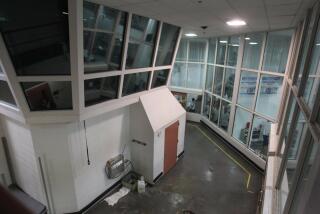Patient’s Death Leads to Probe by County
- Share via
Los Angeles County health officials are investigating the case of 31-year-old Torin Comeaux, a gunshot victim who died after Martin Luther King Jr./Drew Medical Center’s trauma unit staff spent six hours trying to find a vascular surgeon to operate on him before giving up and transferring him to another hospital.
Because King/Drew is a designated Level 1 trauma center--the highest rating in the county’s emergency response network--it is obliged to be ready for all types of life-threatening medical emergencies in the wide swath of south Los Angeles it serves.
Vascular surgeons repair and reconstruct veins and arteries, a frequent necessity in trauma units. The bullet that struck Comeaux’s knee damaged the vessels that carried blood through it.
King/Drew handles such a large number of extremely sick and badly injured patients that it once was used by the military to train combat surgeons. A staggering 75% of its patients are admitted through the emergency room, a significant number of them having suffered multiple gunshot wounds. Moreover, its trauma unit, which scored highly in a recent survey by the American College of Surgeons’ Trauma Committee, also has had its share of high-profile successes. Those include saving the lives of schoolteacher Alfredo Perez and young Dodger fan Richard Bautista, both of whom were brought there in critical condition after being shot in the head.
Several county officials said they are investigating the Comeaux case. One of them, Virginia Hastings, director of the county’s Emergency Medical Services Agency, said the agency is concerned about the lack of a vascular surgeon and the delay in moving the injured man.
Even so, Hastings said the probe should not be viewed as an “indictment” of King/Drew. “This should be viewed as a tragic case that we can all learn from and correct,” she said. “The community shouldn’t lose confidence in that hospital. They see thousands of these patients each year.”
King/Drew’s trauma center contract with the county requires the hospital to have at least one vascular surgeon on call and not more than 30 minutes from the facility’s emergency room. Without immediate and specialized surgical repair of damaged veins and arteries, patients can lose limbs, or even die from loss of blood, medical experts say.
According to several medical staff members at King/Drew and hospital records, however, none of the trauma center’s four vascular surgeons could be found on the afternoon and evening of April 12, a Saturday, when Comeaux was taken to the emergency room after being shot in the leg while driving his young son and the boy’s friend to a go-cart track.
Comeaux was wheeled into the emergency room at 4:38 p.m. Attending physicians determined that he needed immediate surgery. But as his left leg grew more swollen and his vital signs weakened, hospital sources said, staff members frantically tried to locate one or more of the hospital’s vascular surgeons, as well as some of the trauma center’s top managers. Neither the surgeons nor the officials could be found, the sources said.
“By the time I got in [at 7 p.m.], the patient had already been in the ER for a couple of hours,” said one King/Drew resident doctor, Kevin Calhoun, who signed some of Comeaux’s treatment records. “The patient was transferred because we didn’t have vascular coverage at that time. He required surgery that we couldn’t give him.”
By 9 p.m., doctors had given Comeaux a patient transfer acknowledgment, which he appears to have signed, below a scribbled doctor’s note saying: “Vascular injury needs immediate repair. Not able to repair vascular injury.” At 10:55 p.m., long after Comeaux’s relatives say they had begun demanding to know why he had not been treated, he was airlifted by helicopter from Willowbrook to the County/USC Medical Center trauma unit in Boyle Heights. At that point, he was in “fair” and “stable” condition, according to King/Drew’s patient transfer records.
But a confidential health department “preliminary chronology” obtained this week says Comeaux was in “critical condition,” when he arrived at County-USC and suffered a grand mal seizure.
A senior health official confirmed that Comeaux suffered the seizure sometime around 11:30 p.m., as he was arriving at the emergency room, and had to be resuscitated.
One emergency room surgeon Tuesday said such seizures are often caused by a significant lack of oxygenated blood flowing to the brain.
At 12:45 a.m., Comeaux was fully resuscitated and was transported to the operating room, where surgery began at 1:05 a.m., said the chronology and the source. At 8:30 a.m., surgery was completed and Comeaux was taken to the intensive care unit.
He died there at 9:45 a.m., according to a County-USC source.
Disagreement Over Actions
Neither King/Drew nor county health officials could explain the delay in moving Comeaux, but say they will investigate. County officials, who asked not to be named, also say they will look into whether King/Drew’s description of his condition as “stable” was accurate.
The county coroner’s preliminary conclusion is that Comeaux died from the single gunshot wound. Some King/Drew staffers disagree.
“There is no question that [Comeaux] could have been saved,” said one emergency room physician. “The worst case, in 5% of situations like these, is that he could have lost his leg. But he should not have lost his life.”
According to Comeaux’s family, emergency room doctors at County-USC agreed.
Carol Green-Howard, Comeaux’s sister, says a County-USC trauma doctor told her that “he couldn’t understand why [Comeaux] wasn’t brought there immediately. He said my brother shouldn’t have died.”
“It just doesn’t seem fair,” said Comeaux’s mother, Mae, who buried her only son April 21. “The doctors at USC tried to do all they could do, but he got there too late. . . . They said my son bled to death.”
Officials at County-USC have declined repeated requests for comment on the entire incident, saying it is under review.
“Eventually the facts will speak for themselves,” said Dr. Ronald Kaufman, hospital chief of staff.
But several sources at the hospital said they are “very concerned” about the delays--and the patient’s condition when he arrived.
They also said that even though Comeaux was overweight, at more than 300 pounds on a 6-foot-plus frame, he did not appear to have suffered a heart attack that could have contributed to his death.
“In situations like this, there often are mitigating circumstances,” one of the officials said. “But am I concerned about this one? Yes, I am very concerned.”
In an interview, King/Drew Administrator Randall Foster said the trauma center now has vascular surgeons available, but he confirmed that his staff could not find such a specialist to treat Comeaux.
Foster, who took over leadership of the troubled hospital last year as part of a “crisis management team,” declined to discuss why it took so long to transfer Comeaux, or why top administrators could not be reached that night. And although Foster confirmed that Mercy Air helicopter service was called in to transport Comeaux, he said he could not comment on whether that created additional delays “because it is still under review.”
Foster said the vascular surgeon on call when Comeaux was admitted to King/Drew’s emergency room had left town because of a death in the family. The administrator declined to identify the physician, however.
Another county-paid vascular surgeon at King/Drew also was out of town, Foster said, and a third had been “hospitalized for a month and a half.” The fourth, a part-time employee, was unavailable.
Foster also would not comment on why King/Drew’s publicly posted “General Surgery Call Schedule” for April had blank slots for both attending and backup vascular surgeons from April 11 to April 30.
However, on April 22--10 days after Comeaux’s death--Foster sent a letter to Hastings, of the Emergency Medical Services Agency, saying “the unavailability of a vascular surgeon” would force King/Drew to turn away all trauma patients requiring vascular surgery until the next Monday, April 28.
Moreover, Foster said he could not “directly” contradict another allegation made by several official sources knowledgeable about the case: King/Drew, they say, never alerted paramedics, neighboring hospitals or, most important, the county emergency medical network’s communications center of the missing vascular surgeons.
Such notifications are required by the county to ensure that emergency medical personnel can reroute patients to other trauma centers with appropriate specialists available to provide immediate care, the county’s Hastings said.
“In general, and this is the whole reason we have trauma centers, the idea is speed, speed, speed so you don’t bleed to death,” Hastings said in an interview. “There have been concerns raised about the amount of time it took for the patient to arrive at County-USC. If they did not have a vascular surgeon and if they did not advise the system of that,” Hastings said, “that is of concern to us.
“I’m not looking at the quality of care the patient received [at County-USC],” Hastings added. “We are looking at whether King was following procedures, and we know that they did not.”
Hastings said she is also concerned about why medical staff at King/Drew called for a helicopter to transport Comeaux to County-USC when an ambulance would have been much quicker.
“That helicopter should not have been used; that is also something we are looking at,” Hastings said. “People tend to think helicopters speed things up, when really they slow them down in urban areas.”
According to Hastings, the doctors had to summon a private helicopter from Mercy Air Service Inc. in Fontana in San Bernardino County, causing at least an hour of additional delay. She said the chopper was dispatched at 10:15 p.m., arrived at King/Drew at 10:40 p.m., left King/Drew at 11:16 p.m. and arrived at County-USC’s helipad at 11:32 p.m. There, Comeaux had to be transferred to an ambulance anyway to get him to the emergency room.
“It certainly was a time factor. Whether it was a determining factor, who knows,” Hastings said. “But when you put one delay on top of another, you are causing problems.”
The Comeaux case is not the first to draw attention to the medical center’s practices.
Earlier Investigation
“There is no question that we have seen far more potentially criminal cases--mostly deaths from allegedly poor care--coming from King than from any other facility in the county, public and private,” said Deputy Dist. Atty. Brian Kelberg, who has headed the county prosecutor’s medico-legal section since 1984. He said many of the ongoing problems at the hospital are not a question of economics but of incompetent care and management.
Kelberg’s assessment is based, in part, on a three-year investigation of King/Drew conducted by his unit and the state Medical Board. It was prompted by suspicions that the hospital was covering up problems that may have contributed to the death of Sheriff’s Deputy Nelson Yamamoto in March 1992, two days after he was admitted to King/Drew for wounds he suffered in a gun battle with a suspected murderer.
In the Yamamoto case and at least five other “preventable deaths,” Kelberg and his team found what they described as medical malpractice and mismanagement. The investigators also recruited nationally recognized trauma expert Dr. Donald Trunkey, who Kelberg said used King/Drew’s own statistics to conclude that the hospital had more problems than similar overworked trauma centers in large urban areas.
Last week, in fact, the county claims board approved an out-of-court settlement of the wrongful-death case subsequently brought by Yamamoto’s parents. If that action is ratified by the Board of Supervisors, the Yamamotos will receive $97,083 in compensation, plus $55,417 for legal fees and $22,500 for court costs.
The state Medical Board still is investigating three doctors in the Yamamoto case. Deputy Atty. Gen. Mark Roohk said their cases could be resolved within the next few weeks. Administrative charges were dropped against a fourth doctor, who was a resident at the time.
In response to the district attorney’s office’s findings, Supervisor Yvonne Brathwaite Burke--whose district includes King/Drew--called for immediate reforms. Ultimately, she ordered a takeover of King/Drew by Foster’s crisis management team.
Last week, Burke expressed confidence in Foster, but conceded that “it has been difficult to make changes at the hospital. It is very frustrating,” she said, in part blaming the county chief administrative office for freezing so many vacant positions at King/Drew that the hospital administrators “have had to bring in contract staff just to meet credentialing” requirements when accreditation agencies visit. In the past, those agencies have threatened sanctions against King/Drew for being understaffed for critical positions.
However, Burke said, the Comeaux case “is absolutely something I plan to look into.”
Shortages of Staff, Funding Blamed
Foster and other King/Drew administrators defend the quality of the hospital’s medical care, but also say it is underfunded compared with other county facilities. They blame the continuing problems on an overworked staff, outdated equipment and county budget cuts.
They also contend that the crisis management team installed last year is turning things around. “Those things that occurred in the past are obviously lessons for us to learn from,” Foster said. But “if you juxtapose the past with the present, you can see monumental changes.”
Such assurances are irrelevant to Mae Comeaux. She spent part of last Wednesday consulting plaintiffs’ attorney Milton Grimes. The rest of the day, like most of those since her son’s death, was passed alone in her Long Beach home, where she grieves over pictures of him.
“I will miss him every single day of the rest of my life,” she said. “He was my baby. He will always be my baby.”
More to Read
Sign up for Essential California
The most important California stories and recommendations in your inbox every morning.
You may occasionally receive promotional content from the Los Angeles Times.










